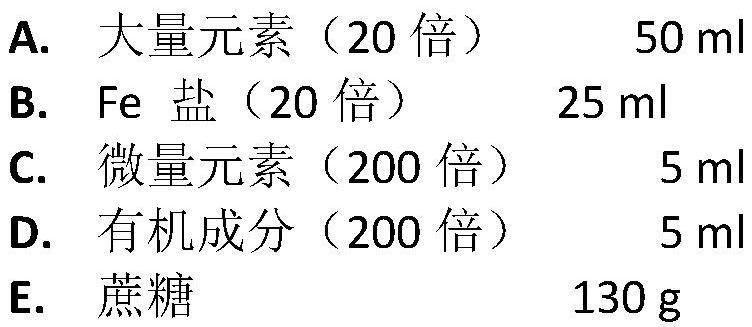A kind of high-efficiency cultivation method of rapeseed microspores
A culture method and technology of microspores, applied in the field of high-efficiency culture of rapeseed microspores, can solve the problems of low doubling rate and low embryo emergence rate
- Summary
- Abstract
- Description
- Claims
- Application Information
AI Technical Summary
Problems solved by technology
Method used
Image
Examples
Embodiment 1
[0027] This embodiment provides a method for high-efficiency cultivation of rapeseed microspores, the steps comprising:
[0028] 1. Take materials
[0029] The sampling time is between 10:00 a.m. when the weather is fine, and the buds of the main inflorescence are selected as the site for sampling. The inflorescence has the following characteristics:
[0030] 1) It is best to choose the main branch. The inflorescence of the main branch is very important for the embryo emergence rate (the pollen vitality of the main inflorescence is strong, and the development period of the microspores is more consistent). The inflorescence on the selected main branch has bloomed, and the number of blooms is between 1-10, and the bud emergence rate of the main inflorescence with 3-5 flowers is relatively high.
[0031] 2) When selecting flower buds, do not choose those with exposed stigmas and cracked flower buds to avoid incomplete sterilization;
[0032] 3) If there is no suitable main infl...
Embodiment 2
[0097] This embodiment provides a method for high-efficiency cultivation of rapeseed microspores, the steps of which are basically the same as in Example 1, the difference being:
[0098] The doubling process is as follows:
[0099] 1) Dilute the precipitated pollen with NLN-16 liquid medium containing 16mg / L colchicine (note: the dilution should not exceed 10ml, because after doubling, it will be diluted and centrifuged again in a 10ml centrifuge tube), and poured into a triangle The bottle was cultured in the dark at 31.5°C for 60 hours;
[0100] 2) After 60 hours, check whether there is any contamination. If there is no contamination, separate the dishes and continue to cultivate;
[0101] The embryo induction culture process is as follows:
[0102] 1) Pour the doubled non-contaminated NLN-16 pollen suspension into a centrifuge tube again and centrifuge at 800 rpm for 5 minutes, pour off the NLN-16 liquid, and leave the precipitated pollen;
[0103] 2) Dilute the precipi...
Embodiment 3
[0107] This embodiment provides a method for high-efficiency cultivation of rapeseed microspores, the steps of which are basically the same as in Example 1, the difference being:
[0108] The doubling process is as follows:
[0109] 1) Dilute the precipitated pollen with NLN-16 liquid medium containing 14mg / L colchicine (note: the dilution should not exceed 10ml, because after doubling, it will be diluted and centrifuged again in a 10ml centrifuge tube), and poured into a triangle The bottle was cultured in the dark at 32.5°C for 55 hours;
[0110] 2) After 55 hours, check whether there is any contamination. If there is no contamination, separate the dishes and continue to cultivate;
[0111] The embryo induction culture process is as follows:
[0112] 1) Pour the doubled non-contaminated NLN-16 pollen suspension into a centrifuge tube again and centrifuge at 800 rpm for 5 minutes, pour off the NLN-16 liquid, and leave the precipitated pollen;
[0113] 2) Dilute the precipi...
PUM
 Login to View More
Login to View More Abstract
Description
Claims
Application Information
 Login to View More
Login to View More - R&D
- Intellectual Property
- Life Sciences
- Materials
- Tech Scout
- Unparalleled Data Quality
- Higher Quality Content
- 60% Fewer Hallucinations
Browse by: Latest US Patents, China's latest patents, Technical Efficacy Thesaurus, Application Domain, Technology Topic, Popular Technical Reports.
© 2025 PatSnap. All rights reserved.Legal|Privacy policy|Modern Slavery Act Transparency Statement|Sitemap|About US| Contact US: help@patsnap.com



